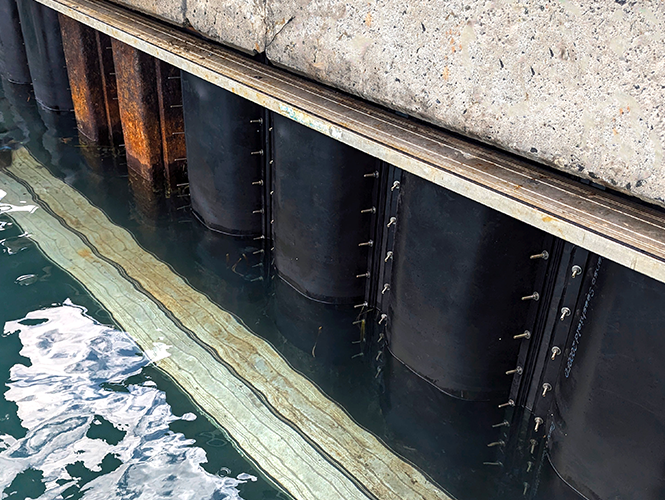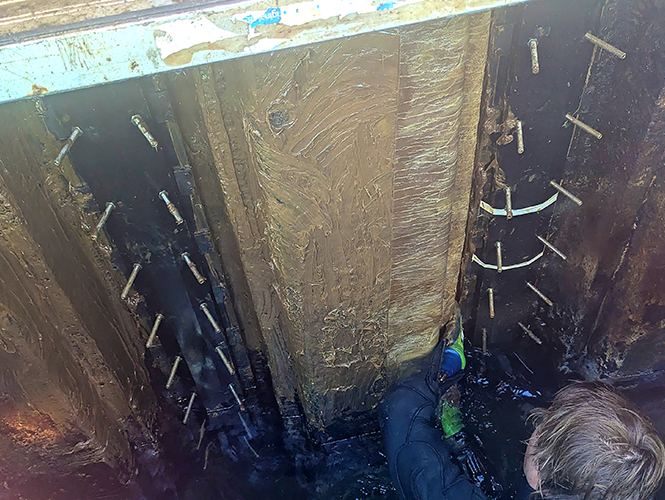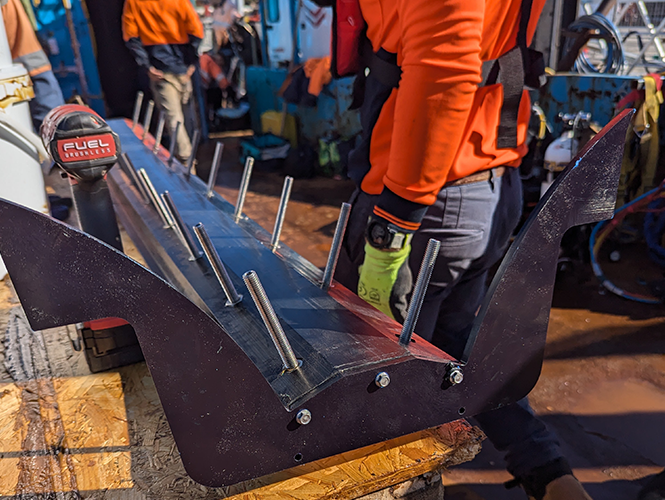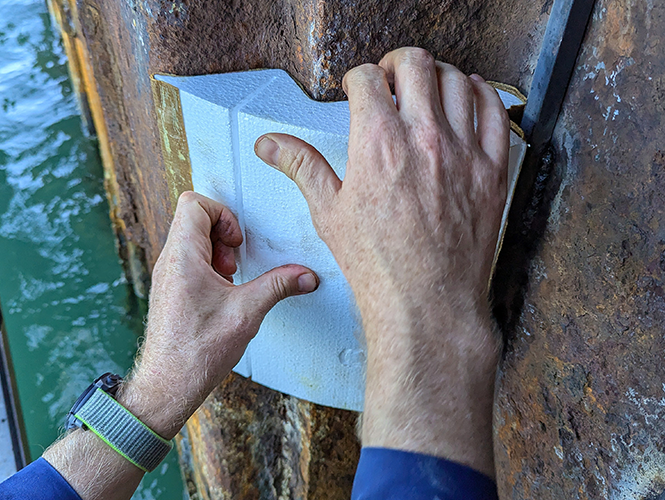SeaShield 2020SP™ System







A petrolatum system for protection of sheet piles, comprising of HDPE jacket with welded supporting bars. Used with Denso SeaShield Primer, Denso™ Marine Piling Tape, Denso Mastic™, wall attachment spines, foam blocks and 316 stainless steel fasteners for tensioning and attachment of jacket to wall attachment spine.
The SeaShield 2020SP™ System can be used on Z-piles, U-piles and combined walls of all sizes and types. It can accommodate and encapsulate tie rod heads and, subject to specific design, can be used on most walls with fenders, ladders, drainage outlets, cathodic protections hangers, waling beams or other features. The system is suitable for harbours, ports, channels and seawalls in marine environments.
Contact us for a free general assembly drawing of your sheet pile wall asset.
Request Safety Data Sheets (SDS)- Based on the SeaShield 2000FD™ System – proven over decades of use
- Abrasion resistant
- UV resistant
- Individually custom made to suit each sheet pile wall
- Easily removed for inspection
- Stable over a wide temperature range
- Non-hardening or cracking
- Accommodates vibration and movement of substrate
- Highly resistant to mineral acids, alkalis and salts
-
Denso SeaShield 2020SP
datasheet
-
SeaShield Series 2020SP Engineering Specifications
application instructions
-
SeaShield 2020SP System Brochure
literature -
Denso SeaShield 2020SP Abstract
literature -
Denso SeaShield Brochure
literature
Product FAQ
What is the expected life of the 2020SP system?
The system is based on the proven SeaShield 2000FD system. More specifically, it is based on the 2000FD system as applied to H-piles or octagonal piles, which also use foam blocks to ‘round out’ the pile. These systems have been proven over decades of use to provide a life of 25+ years while preventing virtually all corrosion.
In comparison, painted systems are expected to last for 6-8 years and often prematurely fail in marine environments. This will allow corrosion to continue wherever the coating breaks down – particularly in existing pitted areas.
Is the 2020SP system easy to apply?
Yes, the SeaShield 2020SP system is easily applied by trained applicators and does not require specialised equipment. A boilermaker is required to attach the system using 5mm fillet welds. Denso can provide training to contractors or staff of the asset owner. Denso will provide full installation instructions customised to the project as well as templates for inspection and test plans. Surface preparation requires only removal of marine growth and loose corrosion. A high-pressure water blast followed by a quick scrape is typically the most efficient way to achieve this.
What sort of access is required?
Applicators could use a rigid platform, such as a forklift movable platform or scaffold, or floating system such as small barge or pontoon system. For floating systems, applicators should ensure the platform is stable and held against drifting. Having all materials and tools available and easy to access will greatly improve productivity of the works. Further general advice can be provided based on your particular project.
What is the typical cost of the system?
The costs of the system will depend on the size and arrangement of the sheet pile wall plus any additional features requiring protection. The price is generally made up of around 50% material costs and 50% application costs. In most cases the system is expected to be similarly priced to a single application of a paint coating using abrasive blasting preparation. However, the SeaShield 2020SP will last several times longer than a paint coating. In many applications, such as heavily corroded walls, use of the Seashield 2020SP system will save significant project costs compared to a paint coating due to the reduced need for surface preparation and welded repairs to corroded surfaces. With a paint coating, the likelihood of breakdown of the coating on a previously corroded and pitted surface is very high without a significant cost in welded repair or grinding of pitted areas, but the SeaShield 2020SP system is able to fill the pitted surfaces and provide excellent corrosion protection without any additional cost or effort in these areas.
Do I need to inspect the system? I can’t see underneath, how do I know it’s working?
The SeaShield 2000FD system has decades of case studies showing excellent results. Many case studies of inspections after many years of service have been published in the Denso Digest. An annual inspection of the outside of the jacket, and repair of any visible damage from boat impacts or other causes is recommended. As part of a responsible asset management system asset owners may wish to remove, inspect and re-install several jackets or a small percentage of the total every 5-10 years to prove the effectiveness of the system. Denso would love to hear your results from any inspections and would consider showcasing your results in the Denso Digest.
My sheet pile wall is very corroded, can I use this product?
Where structural repair is required, the product can accommodate repair plates. Denso Australia would be happy to work with the appointed structural engineer to ensure the repair methodology allows for the simplest possible installation of the system following repair.
While not a structural repair product, the SeaShield 2020SP has significant benefits for application on a heavily corroded wall, that can save significant costs on your project.
Your appointed structural engineer will need to advise whether the sheet pile wall is structurally sound or requires structural repair. However, since petrolatum tape systems can effectively halt corrosion, engineers can often specify no repairs or only minimal repairs whereas without a petrolatum system in place engineers must allow for future corrosion allowances.
Further, for a paint coating project, deeply pitted areas would require welded repair or grinding out of pits to ensure a quality paint coating. This preparation is often neglected, or is cost prohibitive, and the paint breaks down after a few years. When this happens, corrosion continues in the deep pits leading to potential holing of the wall. With a petrolatum system the deep pits are filled with SeaShield marine primer and are totally protected without additional effort or cost required. For areas where the wall contains small holes, but is otherwise structurally sound, these holes can be filled with a Seashield Epoxy system prior to application of the SeaShield 2020SP.
Note the attachment method for this product generally requires a minimum thickness of 6mm at the attachment point. Where this cannot be achieved, the length of the weld for attachment to the wall can be increased.
What height/ level do you recommend applying the system to?
Where a cathodic protection system is in place, the system should be applied down to at least 200mm below mid-tide. The system should extend to the top of the sheet pile wall which is typically the underside of a capping beam. Where no capping beam is in place, the top can be finished with capping system.
Can the system be applied underwater?
The system can be applied underwater and has been demonstrated on projects to a depth of up to one metre. Applicators can keep working during high tides.
Will the system be damaged by boats?
The 2mm HDPE jacket is tough and puncture resistant. However, a significant impact from a vessel or other object may damage any coating system. Most damage can be repaired by removing the jacket and placing an extra layer of HDPE sheet under the damaged section. For more severe damage, the jacket can easily be replaced with new and any tape can be reinstated. Denso representatives can provide specific advice as required.
Can you provide a quotation?
Yes, we can provide a quotation along with a preliminary design layout showing the size of jackets and the installation. We require drawings if available or otherwise the width of the sheet pile profile. We also some information on the tidal levels, level of the capping beam and some photos of the wall showing any tie backs etc.
Can the system be used with tie-backs/ fenders/ ladders, etc?
Generally yes, we have designs to work around and even protect many typical sheet pile wall fixtures. The particulars of any wall and method of protection are shown in the preliminary design drawings. In some cases, the fixtures on the wall may make it unsuitable for use of this system without modification to those fixtures.
How is this better than the cathodic protection system I already have?
CP is great, but it only works up to the mid-tide level. The areas with the highest rates of corrosion are the low-water level and the splash zone. The low water level can be protected by a properly designed and maintained CP system, but the splash zone must be protected by a coating system such as a paint or the SeaShield 2020SP.
In some cases it is not feasible or economic to apply a cathodic protection system, such as in freshwater lakes. In this case, the SeaShield 2020SP can be applied underwater as well as above water to provide protection to the entire wall.
If your sheet pile wall doesn’t have cathodic protection or splash zone protection, please talk to us further about incorporating the installation of the SeaShield 2020SP and a cathodic protection system in the one project. Note that Denso does not design or supply cathodic protection systems but will be happy to discuss the integration of the installation with your CP designer.
Will the system withstand turbulence, eg. from a ship’s thruster?
Yes, a protective HDPE cap is installed at the bottom of the installation to protect and seal the system.
case Studies
view allCan’t find what you are looking for?
If you can't find the information you require, need help understanding anything you may have read, or have a general query regarding our products and services, contact us today and one of our representatives will be in touch to help you with your query.




